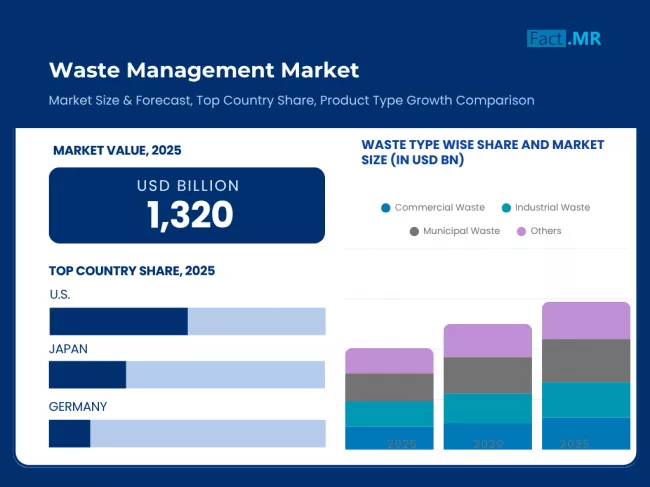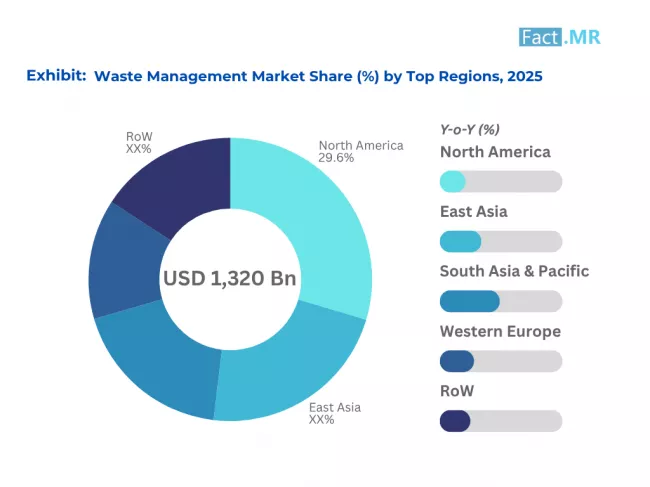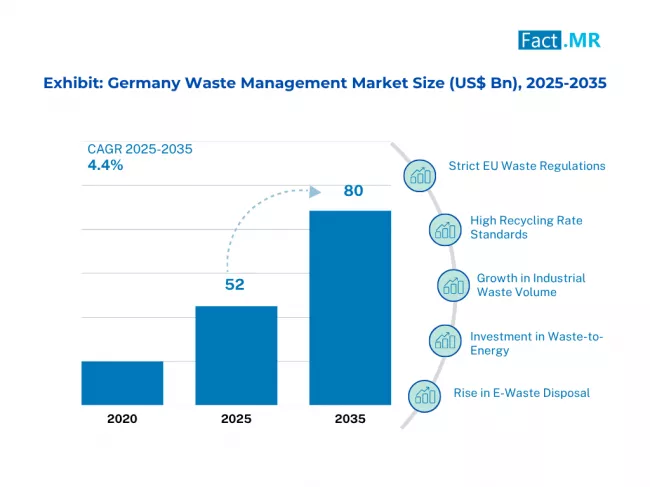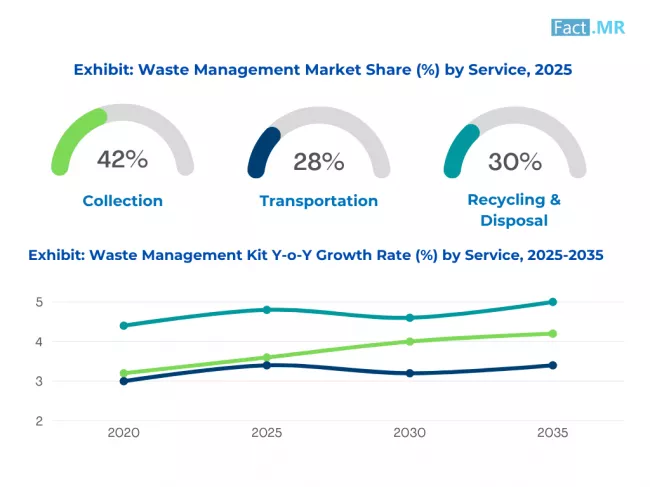Waste Management Market
Waste Management Market Analysis, By Service, By Waste Type, By End Use Industry, and Region - Market Insights 2025 to 2035
The Collection segment is projected to grow at a CAGR of 3.5%, whereas another segment Transportation is likely to grow at 3.6%. In terms of countries Germany is projected to grow at 4.4%, followed by USA at 3.3% and Japan to grow at 4.7%.
Waste Management Market Outlook (2025 to 2035)
The global waste management market is expected to reach USD 1,862 billion by 2035, up from USD 838 billion in 2024. During the forecast period from 2025 to 2035, the industry is projected to register a CAGR of 4.3%, driven by growing urbanization, industrialization, and increasing environmental awareness.
Government regulations, AI-powered technologies, and circular economy models are further accelerating market growth. The ever-increasing e-waste, partnerships between governments and businesses, and investments related to ESG are other driving forces.

What are the drivers of Waste Management Market?
The world waste management industry is largely powered by rising levels of urbanization, industrialization and a more environmentally conscious population. Due to the increase in population in the cities, the quantity of municipal solid waste (MSW) increases to the extent that it requires orderly types of waste disposal. Governments are also taking strict measures to encourage recycling, source-based segregation and scientific disposal processes, which contribute to the growth of the demand for integrated waste management products and services.
Other upcoming technologies that are transforming the industry include the use of artificial intelligence in sorting, the waste-to-energy (WtE) technologies, and smart tracking waste systems. Use of public-private partnerships (PPPs) is becoming common, particularly in the new economies, in an attempt to enhance infrastructure and delivery of services. The adoption of the circular economy by all industries is also gaining momentum, which is beneficial for ensuring sustainable waste treatment and recycling.
In addition, the increasing demand of specialized disposal services is caused by the increase in the quantity of hazardous waste and e-waste as a result of the explosion of consumer electronics and rise in healthcare provisions. The increasing attention of investors in sustainable infrastructure and ESG-compatible businesses is also one of the most potent catalysts in the expansion of the market worldwide.
What are the regional trends of Waste Management Market?

The waste management market in North America is large due to its old infrastructure, high per capita waste generation, and stringent environmental regulations. The USA is at the top of the list, with extensive recycling programs, the use of landfills as alternatives, and numerous opportunities for waste-to-energy.
Europe is not far behind, and the European Green Deal and high targets in waste reduction, recycling and interests in the circular economy have fueled this trend. Germany, Sweden, and Netherlands are among the leaders in zero-waste and efficiency of incineration.
The fastest-growing region is the Asia-Pacific, which is boosted by the high pace of industrialization, growth rates in urbanization, and changes in policies in China, India, and Southeast Asia. The prohibition on importing foreign waste by China has induced domestic processing potential, and India is investing in smart cities and a decentralized waste segregation system.
Brazil, South Africa, and the UAE are slowly on the path of transformation in Latin America and the Middle East, making progress through awareness creation and international engagement. The collection and sorting of waste are largely dominated by informal waste sectors in several countries, which affects the pace of modernization.
What are the challenges and restraining factors of Waste Management Market?
The establishment and maintenance of waste treatment infrastructure are among the major challenges in the waste management market, primarily due to the high operational costs. Investments in advanced recycling and WtE are very capital-intensive; thus, small and mid-sized municipalities fail to invest in these technologies.
Varying laws, rules, and regulations in different areas also complicate the unified market. A weak policy framework and the prevalence of the informal sector hinder smooth waste collection, segregation, and disposal systems in developing economies.
Customer awareness and involvement are yet another limitation. The poor uptake of source segregation and recycling habits by the people remains an obstacle, particularly in rural and underserved areas. In addition, cities often lack space to build landfills and face opposition to establishing incineration facilities due to environmental concerns.
Hazardous and e-waste management is also complicated because it is subject to compliance and specialized handlers. Geopolitical factors, labor, and commodity prices of recycled materials are factors that render the financial viability and sustainability of waste management operations around the world uncertain.
Country-Wise Outlook
Circular economy and policy leadership define waste management in Germany

Germany is one of the leading countries in waste management globally, with well-established environmental policies, ambitious circular economy goals, and a long history of implementing waste-to-energy solutions, all of which were adopted well before the rest of the world. Active packaging laws and Extended Producer Responsibility (EPR) policies in the country have stimulated the recycling of high volumes of municipal waste, reaching above 65 percent. The fact that Germany should minimize landfill use and switch to climate-neutral waste treatment remains another innovation driver.
Smarter bins, advanced automated sorting of materials, and facilities with anaerobic digestion are becoming the standard in cities and towns. The German government continues to promote the idea of digital waste tracking technologies and intersectoral cooperation to enhance recycling. EU Green Deal investments in RDF (refuse-derived fuel) and bioenergy from waste are increasing in line with the EU Green Deal and Germany's Progress (Resource Efficiency Programme).
Tech-enabled recycling and urban waste reform lead the USA market
Leading the waste management market are the United States, which have huge urban populations, industrial production, and a growing demand for modernization with sustainable retailing. Issues such as excessive landfill utilization and inconsistent state regulations are identified as key challenges; however, the rise in the number of materials recovery facilities (MRFs) and public-private partnerships is changing the scene.
Recycling robotics powered with AI (e.g., AMP Robotics) and fleet tracking based on the Internet of Things or smart landfill gas recovery systems are on the rise. Federal grants facilitate modernization under the Bipartisan Infrastructure Law, as outlined in the EPA's National Recycling Strategy. The municipalities of cities like San Francisco and Seattle are striving to become zero-waste cities, which is shaping local policy and driving innovation.
Japan’s precision waste sorting and society 5.0 propel market efficiency
The management of waste in Japan is impressive, as it operates according to strict sorting procedures, has limited landfills, and a culturally ingrained focus on cleanliness and obedience. With more than 70 percent of disposed waste being recycled by burning it as a means of generating energy, the country has focused its investment efforts on high-efficiency and low-emission waste-to-energy facilities.
Components of technological integration envisioned in Japan's Society 5.0 vision include the use of smart collection logistics, AI-assisted recycling lines, and one of the apps that enable the personalization of waste categorization. The Basic Act promotes both urban and rural circular activities for establishing a Sound Material-Cycle Society. Issues concerning the increase of electronic waste and old infrastructure still persist, although the innovation makes Japan a leader in dealing with waste in its urban regions.
Category-Wise Analysis
Collection services anchor the frontline of waste management operations

Collection services are the guiding force of the waste management industry, ensuring that waste is picked up and routed to disposal, recycling, or treatment centers in a timely manner. The services are necessary for sustaining the health of both people and the environment, ensuring no environmental contamination and facilitating sustainability requirements.
The smart bin, route optimization software, and fleet electrification are all being developed to boost efficiency and compliance. With the growing trend of urbanization, municipal collaborations and outsourcing of waste collection services are expanding the business facets of waste collection services.
Commercial waste streams push demand for segregated handling and regulatory compliance
The commercial waste, resulting from office buildings, retail centers, restaurants, and institutions, makes up a significant percentage of the total amount of waste. It requires specialized treatment, separation, and mostly recycling or composting options according to the regulations. The emergence of zero-waste initiatives and ESG ambitions is encouraging companies to invest in traceability in waste processing procedures. The appearance of sustainability as a brand asset is moving away a business need that has made commercial waste management adopt data-driven and more circular economy-friendly systems.
Residential sector drives waste volume but lags in diversion a growing focus for policy and innovation
The residential sector makes a significant contribution to overall waste production, particularly in urban and suburban areas. This sector is receiving increasing policy attention as curbside recycling, food waste composting, and e-waste collection expand. Governments and local authorities are strengthening information campaigns and implementing source segregation requirements.
Competitive Analysis
Waste management trends in the global economy are characterized by high competition due to innovation, regulatory requirements, and the diversification of services. Improvements in recycling technologies, waste-to-energy technologies, and digital monitoring platforms are key drivers in the market that differentiate companies. Its strategic focus, instead, is set on automation, route optimization of collection services, and the use of AI-based sorting systems, which reduce operational costs and improve service efficiency.
Some of the strategies used to expand their geographical territories and regulatory compliance include mergers, regional expansions, and partnerships with local municipalities. Regional fragmentation also occurs in the market, whereby small to mid-sized companies provide specific services, including hazardous waste disposal, construction debris reuse services, and electronic waste management.
Sustainability metrics play a major role in determining competitive positioning. Companies that have good environmental performance reporting, closed-loop processes, and carbon-neutral logistics tend to gain a competitive edge in countries that are concerned about the environment, such as those in Europe and North America.
Circular economy models and innovation in material recovery are key areas of investment where companies aim to gain a competitive edge in the market. The trend toward a stricter regulatory environment and more ambitious sustainability objectives worldwide will make competition in the sphere of compliance-based service provision and environmentally efficient technologies ever tighter.
Key players in the waste management industry include Veolia Environnement S.A., Waste Management, Inc., Republic Services, Inc., Waste Connections, Inc., Clean Harbors, Inc., GFL Environmental Inc., Remondis SE & Co. KG, Suez S.A., Covanta Holding Corporation, Stericycle, Inc., and other notable companies.
Recent Development
- In July 2025, Arc Ento Tech, an Australian waste-to-energy startup, reported a financial turnaround, achieving a USD 1 million annual profit, compared to a USD 1 million loss the previous year. The company is expanding its operations by building three landfill sites in Sydney and aims to scale its waste processing capabilities, targeting a monthly revenue of USD 1.5 million.
- In December 2024, Croatia's Ministry of Environmental Protection and Green Transition, along with the Environmental Protection and Energy Efficiency Fund, announced a plan to invest €651.8 million in waste management projects in 2025. The initiatives include removing waste from contaminated sites, remediating polluted land, constructing new waste management infrastructure, and producing electricity from renewable energy sources.
Fact.MR has provided detailed information about the price points of key manufacturers in the waste management market, positioned across regions, as well as sales growth, production capacity, and speculative technological expansion, in its recently published report.
Methodology and Industry Tracking Approach
Fact.MR conducted a market survey of waste management in 2025, gathering feedback from 4,880 authorized stakeholders across 21 countries. Participants were assigned to represent roles in various areas, including science in the anaerobic digestion product, the design of a smart-bin IoT system, the engineering of landfill methane, the innovation of recyclable composite sorting, and the sustainable routing of waste fleet logistics. This survey was conducted with the assistance of at least 80 professionals in each country, the vast majority of whom led projects in real-time AI waste classification, decentralized community-led composting, and bio-waste silos optimized for humidity in tropical climates.
The report outlined key milestones in waste management between June 2024 and May 2025. Among the major trends, there appears to be a further proliferation of AI-advanced segregation units, as well as staggering levels of interest in reusable elements of sanitation systems indoors, in cities, and a gradual transition to blockchain-based waste tracking. Funding began to gather momentum, with an emphasis on investing in miniaturized infrastructure to enable circular material flows, community-based plastic recovery projects, and zero-waste pilot neighborhoods, particularly in developing economies that are progressing toward low-carbon waste management.
Report in the process of tracking since 2018, Fact.MR has maintained a steady focus on audit-friendly e-waste networks, rural waste valorization, and smart mapping of landfills. Worldwide movements towards carbon-free waste solutions, ethical disposal practices, and design-to-break product recycling are now joining these efforts.
Segmentation of Waste Management Market
-
By Service :
- Collection
- Transportation
- Recycling & Disposal
-
By Waste Type :
- Commercial Waste
- Industrial Waste
- Municipal Waste
- Others
-
By End-use Industry :
- Residential
- Commercial
- Industrial
-
By Region :
- North America
- Latin America
- Western Europe
- Eastern Europe
- East Asia
- South Asia & Pacific
- Middle East & Africa
Table of Content
- Executive Summary
- Industry Introduction, including Taxonomy and Market Definition
- Trends and Success Factors, including Macro-economic Factors, Market Dynamics, and Recent Industry Developments
- Global Market Demand Analysis 2020 to 2024 and Forecast 2025 to 2035, including Historical Analysis and Future Projections
- Global Market Analysis 2020 to 2024 and Forecast 2025 to 2035
- Service
- Waste Type
- End-use Industry
- Global Market Analysis 2020 to 2024 and Forecast 2025 to 2035, By Service
- Collection
- Transportation
- Recycling & Disposal
- Global Market Analysis 2020 to 2024 and Forecast 2025 to 2035, By Waste Type
- Commercial Waste
- Industrial Waste
- Municipal Waste
- Others
- Global Market Analysis 2020 to 2024 and Forecast 2025 to 2035, By End-use Industry
- Residential
- Commercial
- Industrial
- Global Market Analysis 2020 to 2024 and Forecast 2025 to 2035, By Region
- North America
- Latin America
- Western Europe
- South Asia & Pacific
- East Asia
- Eastern Europe
- Middle East & Africa
- North America Sales Analysis 2020 to 2024 and Forecast 2025 to 2035, by Key Segments and Countries
- Latin America Sales Analysis 2020 to 2024 and Forecast 2025 to 2035, by Key Segments and Countries
- Western Europe Sales Analysis 2020 to 2024 and Forecast 2025 to 2035, by Key Segments and Countries
- South Asia & Pacific Sales Analysis 2020 to 2024 and Forecast 2025 to 2035, by Key Segments and Countries
- East Asia Sales Analysis 2020 to 2024 and Forecast 2025 to 2035, by Key Segments and Countries
- Eastern Europe Sales Analysis 2020 to 2024 and Forecast 2025 to 2035, by Key Segments and Countries
- Middle East & Africa Sales Analysis 2020 to 2024 and Forecast 2025 to 2035, by Key Segments and Countries
- Sales Forecast to 2035 by Service, Waste Type, and End-use Industry for 30 Countries
- Competitive Assessment, Company Share Analysis by Key Players, and Competition Dashboard
- Company Profile
- Veolia Environnement S.A.
- Waste Management, Inc.
- Republic Services, Inc.
- Waste Connections, Inc.
- Clean Harbors, Inc.
- GFL Environmental Inc.
- Remondis SE & Co. KG
- Suez S.A.
- Covanta Holding Corporation
- Stericycle, Inc.
List Of Table
- Table 1: Global Market Value (USD Bn) and Units Forecast by Region, 2020 to 2035
- Table 2: Global Market Value (USD Bn) and Units Forecast by Service, 2020 to 2035
- Table 3: Global Market Value (USD Bn) and Units Forecast by Waste Type, 2020 to 2035
- Table 4: Global Market Value (USD Bn) and Units Forecast by End-use Industry, 2020 to 2035
- Table 5: North America Market Value (USD Bn) and Units Forecast by Country, 2020 to 2035
- Table 6: North America Market Value (USD Bn) and Units Forecast by Service, 2020 to 2035
- Table 7: North America Market Value (USD Bn) and Units Forecast by Waste Type, 2020 to 2035
- Table 8: North America Market Value (USD Bn) and Units Forecast by End-use Industry, 2020 to 2035
- Table 9: Latin America Market Value (USD Bn) and Units Forecast by Country, 2020 to 2035
- Table 10: Latin America Market Value (USD Bn) and Units Forecast by Service, 2020 to 2035
- Table 11: Latin America Market Value (USD Bn) and Units Forecast by Waste Type, 2020 to 2035
- Table 12: Latin America Market Value (USD Bn) and Units Forecast by End-use Industry, 2020 to 2035
- Table 13: Western Europe Market Value (USD Bn) and Units Forecast by Country, 2020 to 2035
- Table 14: Western Europe Market Value (USD Bn) and Units Forecast by Service, 2020 to 2035
- Table 15: Western Europe Market Value (USD Bn) and Units Forecast by Waste Type, 2020 to 2035
- Table 16: Western Europe Market Value (USD Bn) and Units Forecast by End-use Industry, 2020 to 2035
- Table 17: South Asia & Pacific Market Value (USD Bn) and Units Forecast by Country, 2020 to 2035
- Table 18: South Asia & Pacific Market Value (USD Bn) and Units Forecast by Service, 2020 to 2035
- Table 19: South Asia & Pacific Market Value (USD Bn) and Units Forecast by Waste Type, 2020 to 2035
- Table 20: South Asia & Pacific Market Value (USD Bn) and Units Forecast by End-use Industry, 2020 to 2035
- Table 21: East Asia Market Value (USD Bn) and Units Forecast by Country, 2020 to 2035
- Table 22: East Asia Market Value (USD Bn) and Units Forecast by Service, 2020 to 2035
- Table 23: East Asia Market Value (USD Bn) and Units Forecast by Waste Type, 2020 to 2035
- Table 24: East Asia Market Value (USD Bn) and Units Forecast by End-use Industry, 2020 to 2035
- Table 25: Eastern Europe Market Value (USD Bn) and Units Forecast by Country, 2020 to 2035
- Table 26: Eastern Europe Market Value (USD Bn) and Units Forecast by Service, 2020 to 2035
- Table 27: Eastern Europe Market Value (USD Bn) and Units Forecast by Waste Type, 2020 to 2035
- Table 28: Eastern Europe Market Value (USD Bn) and Units Forecast by End-use Industry, 2020 to 2035
- Table 29: Middle East & Africa Market Value (USD Bn) and Units Forecast by Country, 2020 to 2035
- Table 30: Middle East & Africa Market Value (USD Bn) and Units Forecast by Service, 2020 to 2035
- Table 31: Middle East & Africa Market Value (USD Bn) and Units Forecast by Waste Type, 2020 to 2035
- Table 32: Middle East & Africa Market Value (USD Bn) and Units Forecast by End-use Industry, 2020 to 2035
List Of Figures
- Figure 1: Global Market Value Share (%), Growth Rate (Y-o-Y), and Units Projection by Service, 2020 to 2035
- Figure 2: Global Market Value Share (%), Growth Rate (Y-o-Y), and Units Projection by Waste Type, 2020 to 2035
- Figure 3: Global Market Value Share (%), Growth Rate (Y-o-Y), and Units Projection by End-use Industry, 2020 to 2035
- Figure 4: Global Market Value Share (%), Growth Rate (Y-o-Y), and Units Projection by Region, 2020 to 2035
- Figure 5: North America Market Value Share (%), Growth Rate (Y-o-Y), and Units Projection by Service, 2020 to 2035
- Figure 6: North America Market Value Share (%), Growth Rate (Y-o-Y), and Units Projection by Waste Type, 2020 to 2035
- Figure 7: North America Market Value Share (%), Growth Rate (Y-o-Y), and Units Projection by End-use Industry, 2020 to 2035
- Figure 8: North America Market Value Share (%), Growth Rate (Y-o-Y), and Units Projection by Country, 2020 to 2035
- Figure 9: Latin America Market Value Share (%), Growth Rate (Y-o-Y), and Units Projection by Service, 2020 to 2035
- Figure 10: Latin America Market Value Share (%), Growth Rate (Y-o-Y), and Units Projection by Waste Type, 2020 to 2035
- Figure 11: Latin America Market Value Share (%), Growth Rate (Y-o-Y), and Units Projection by End-use Industry, 2020 to 2035
- Figure 12: Latin America Market Value Share (%), Growth Rate (Y-o-Y), and Units Projection by Country, 2020 to 2035
- Figure 13: Western Europe Market Value Share (%), Growth Rate (Y-o-Y), and Units Projection by Service, 2020 to 2035
- Figure 14: Western Europe Market Value Share (%), Growth Rate (Y-o-Y), and Units Projection by Waste Type, 2020 to 2035
- Figure 15: Western Europe Market Value Share (%), Growth Rate (Y-o-Y), and Units Projection by End-use Industry, 2020 to 2035
- Figure 16: Western Europe Market Value Share (%), Growth Rate (Y-o-Y), and Units Projection by Country, 2020 to 2035
- Figure 17: South Asia & Pacific Market Value Share (%), Growth Rate (Y-o-Y), and Units Projection by Service, 2020 to 2035
- Figure 18: South Asia & Pacific Market Value Share (%), Growth Rate (Y-o-Y), and Units Projection by Waste Type, 2020 to 2035
- Figure 19: South Asia & Pacific Market Value Share (%), Growth Rate (Y-o-Y), and Units Projection by End-use Industry, 2020 to 2035
- Figure 20: South Asia & Pacific Market Value Share (%), Growth Rate (Y-o-Y), and Units Projection by Country, 2020 to 2035
- Figure 21: East Asia Market Value Share (%), Growth Rate (Y-o-Y), and Units Projection by Service, 2020 to 2035
- Figure 22: East Asia Market Value Share (%), Growth Rate (Y-o-Y), and Units Projection by Waste Type, 2020 to 2035
- Figure 23: East Asia Market Value Share (%), Growth Rate (Y-o-Y), and Units Projection by End-use Industry, 2020 to 2035
- Figure 24: East Asia Market Value Share (%), Growth Rate (Y-o-Y), and Units Projection by Country, 2020 to 2035
- Figure 25: Eastern Europe Market Value Share (%), Growth Rate (Y-o-Y), and Units Projection by Service, 2020 to 2035
- Figure 26: Eastern Europe Market Value Share (%), Growth Rate (Y-o-Y), and Units Projection by Waste Type, 2020 to 2035
- Figure 27: Eastern Europe Market Value Share (%), Growth Rate (Y-o-Y), and Units Projection by End-use Industry, 2020 to 2035
- Figure 28: Eastern Europe Market Value Share (%), Growth Rate (Y-o-Y), and Units Projection by Country, 2020 to 2035
- Figure 29: Middle East & Africa Market Value Share (%), Growth Rate (Y-o-Y), and Units Projection by Service, 2020 to 2035
- Figure 30: Middle East & Africa Market Value Share (%), Growth Rate (Y-o-Y), and Units Projection by Waste Type, 2020 to 2035
- Figure 31: Middle East & Africa Market Value Share (%), Growth Rate (Y-o-Y), and Units Projection by End-use Industry, 2020 to 2035
- Figure 32: Middle East & Africa Market Value Share (%), Growth Rate (Y-o-Y), and Units Projection by Country, 2020 to 2035
- FAQs -
What was the global Waste management market size reported by Fact.MR for 2025?
The Global Waste management market was valued at USD 1,320 Billion in 2025.
Who are the major players operating in the waste management market?
Prominent players in the market are Veolia Environnement S.A., Waste Management, Inc., Republic Services, Inc., Waste Connections, Inc., Clean Harbors, Inc., GFL Environmental Inc., Remondis SE & Co. KG, Suez S.A., Covanta Holding Corporation, and Stericycle, Inc.
What is the Estimated Valuation of the waste management market in 2035?
The market is expected to reach a valuation of USD 1,862 Billion in 2035.
What value CAGR did the Waste management market exhibit over the last five years?
The historic growth rate of the Waste management market was 2.8% from 2020 to 2024.